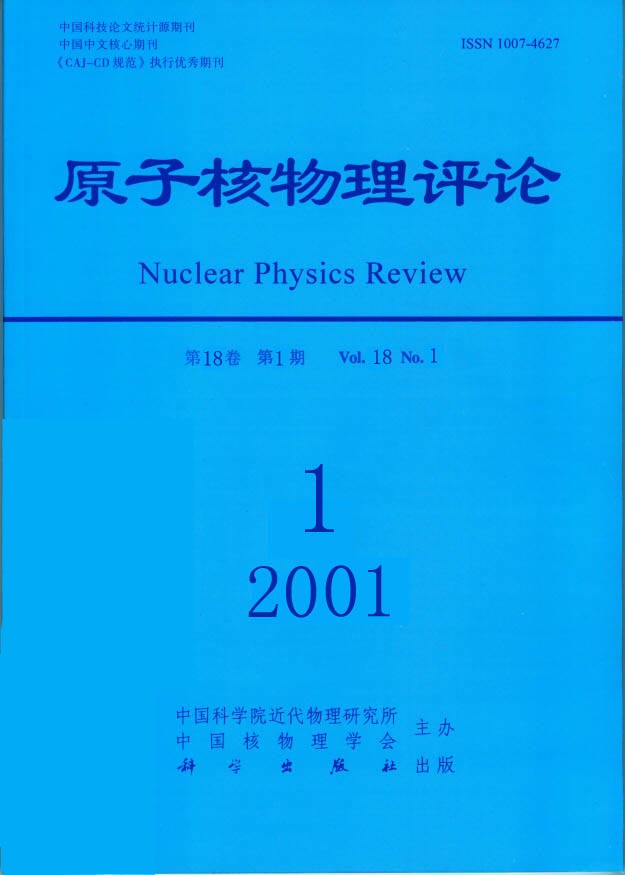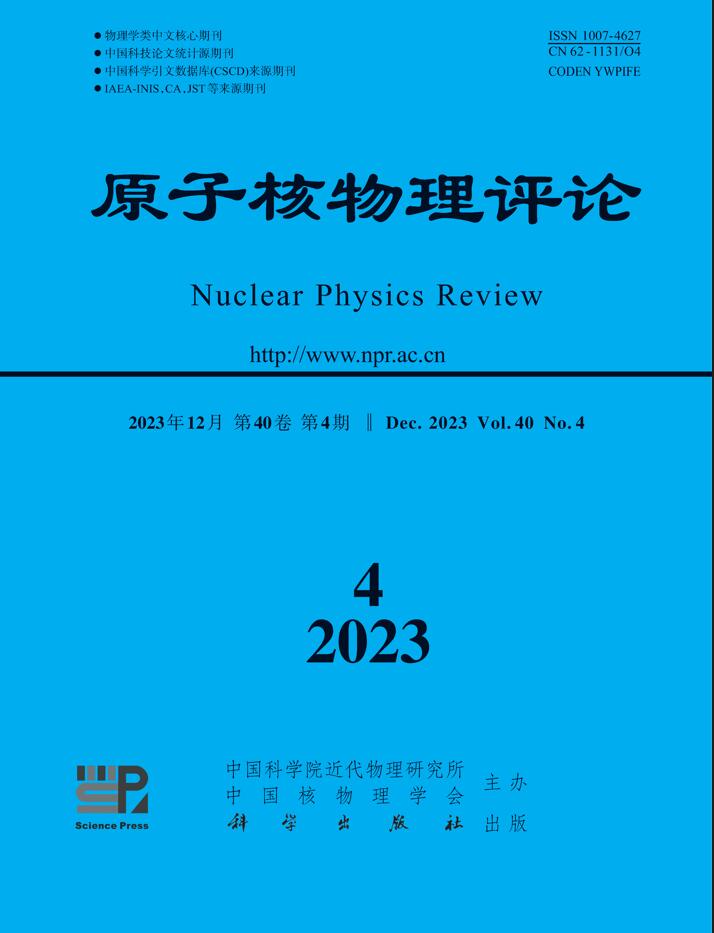2001 Vol. 18, No. 1

Display Method:
2001, 18(1): 1-8.
doi: 10.11804/NuclPhysRev.18.01.001
Abstract:
Properties of exotic nuclei were described by relativistic and norelativistic models. The relativistic mean field theory predicts one proton halo in 26, 27, 28P and two proton halos in 27, 28, 29S. One proton halo in 26, 27, 28P has been found recently in MSU lab. The relativistic Hartree Fock theory was used to investigate contribution of Fock term and isovector mesons to the properties of exotuc nuclei. It turned out that the influence of the Fock term and isovector...
Properties of exotic nuclei were described by relativistic and norelativistic models. The relativistic mean field theory predicts one proton halo in 26, 27, 28P and two proton halos in 27, 28, 29S. One proton halo in 26, 27, 28P has been found recently in MSU lab. The relativistic Hartree Fock theory was used to investigate contribution of Fock term and isovector mesons to the properties of exotuc nuclei. It turned out that the influence of the Fock term and isovector...
2001, 18(1): 9-15.
doi: 10.11804/NuclPhysRev.18.01.009
Abstract:
The strange hadronic matter with nucleon, Λ hyperon and Ξ hyperonis was studied by using an effective model in a mean field approximation. The density dependence of the effective baryon masses as well as the saturation properties and stabilities of the strange hadronic matter were discussed. The result indicates a quite large strangeness fraction range where the multi hyperon nuclear matter is stable against particle emission. In the large strangeness fraction region the Ξ component dominates, result...
The strange hadronic matter with nucleon, Λ hyperon and Ξ hyperonis was studied by using an effective model in a mean field approximation. The density dependence of the effective baryon masses as well as the saturation properties and stabilities of the strange hadronic matter were discussed. The result indicates a quite large strangeness fraction range where the multi hyperon nuclear matter is stable against particle emission. In the large strangeness fraction region the Ξ component dominates, result...
2001, 18(1): 16-20.
doi: 10.11804/NuclPhysRev.18.01.016
Abstract:
Mixed symmetry states were studied in the framework of the neutron proton interacting boson model(IBM2). It was found that some of the mixed symmetry states with moderate high spins changed very fast with respect to the Majorana interaction. This changes our traditional picture that the maximum F spin states are the lowest in energy, the smaller the F spin, the higher the energy. The minimum F spin states or the state with F spin next to minimum may become the yrast or...
Mixed symmetry states were studied in the framework of the neutron proton interacting boson model(IBM2). It was found that some of the mixed symmetry states with moderate high spins changed very fast with respect to the Majorana interaction. This changes our traditional picture that the maximum F spin states are the lowest in energy, the smaller the F spin, the higher the energy. The minimum F spin states or the state with F spin next to minimum may become the yrast or...
2001, 18(1): 21-29.
doi: 10.11804/NuclPhysRev.18.01.021
Abstract:
Based on the achievements for the intermediate energy heavy ion collision in our recent work and the progresses in the world, the isospin effects and the dependence of the entrance channel conditions on them in the intermediate energy heavy ion collisions were introduced, analysed and commended. From the calculation results by using isospin dependence quantum molecular dynamics, it is clear to see that the nuclear stopping power strongly depends on the in medium isospin dependence...
Based on the achievements for the intermediate energy heavy ion collision in our recent work and the progresses in the world, the isospin effects and the dependence of the entrance channel conditions on them in the intermediate energy heavy ion collisions were introduced, analysed and commended. From the calculation results by using isospin dependence quantum molecular dynamics, it is clear to see that the nuclear stopping power strongly depends on the in medium isospin dependence...
2001, 18(1): 30-34.
doi: 10.11804/NuclPhysRev.18.01.030
Abstract:
It’s assumed that when →0, correct non relative quantum mechanics should be equivalent to Newtonian mechanics. Starting from this point, we slightly revised the widely accepted non relative quantum mechanics such that the mechanics after modification is strictly equivalent to that before the modification when ≠0, and equivalent to Newtonian mechanics in the limit →0. The significance lies in the possibility that if we further postulate that corrected relative quantum mechanics...
It’s assumed that when →0, correct non relative quantum mechanics should be equivalent to Newtonian mechanics. Starting from this point, we slightly revised the widely accepted non relative quantum mechanics such that the mechanics after modification is strictly equivalent to that before the modification when ≠0, and equivalent to Newtonian mechanics in the limit →0. The significance lies in the possibility that if we further postulate that corrected relative quantum mechanics...
2001, 18(1): 35-38.
doi: 10.11804/NuclPhysRev.18.01.035
Abstract:
HIRFL- CSR, a new accelerator project at the Heavy Ion Research Facility in Lanzhou (HIRFL), is a multipurpose Cooling Storage Ring system which consists of a main ring (CSRm) and an experimental ring (CSRe). Beams from HIRFL will be accumulated and accelerated in CSRm, and then transported to CSRe for internal target experiments. The layout, major parameters and main functions of the CSR were described.
HIRFL- CSR, a new accelerator project at the Heavy Ion Research Facility in Lanzhou (HIRFL), is a multipurpose Cooling Storage Ring system which consists of a main ring (CSRm) and an experimental ring (CSRe). Beams from HIRFL will be accumulated and accelerated in CSRm, and then transported to CSRe for internal target experiments. The layout, major parameters and main functions of the CSR were described.
2001, 18(1): 39-42.
doi: 10.11804/NuclPhysRev.18.01.039
Abstract:
The beam accumulation methods of HIRFL CSR(Heavy Ion Research Facility of Lanzhou and Cooler Storage Rings) project were studied. Two accumulation methods will be adopted to increase the beam intensity of CSRm. For both multiple multi turn injection method and RF stacking method, electron cooling of beam plays an important role.
The beam accumulation methods of HIRFL CSR(Heavy Ion Research Facility of Lanzhou and Cooler Storage Rings) project were studied. Two accumulation methods will be adopted to increase the beam intensity of CSRm. For both multiple multi turn injection method and RF stacking method, electron cooling of beam plays an important role.
2001, 18(1): 43-46.
doi: 10.11804/NuclPhysRev.18.01.043
Abstract:
The SSC injection system and the factors which influence the injecting beam energy were described and the capability of the SSC injection system for accepting the mismatching injecting beam energy was calculated. For most cases, small difference exists between the values of actual injecting beam energy and the theoretical requirements. The capability of accepting three typical particals: O 8+ , Xe 22+ and Ar 15+ were calculated for the SSC injection stystem with small variation of the in...
The SSC injection system and the factors which influence the injecting beam energy were described and the capability of the SSC injection system for accepting the mismatching injecting beam energy was calculated. For most cases, small difference exists between the values of actual injecting beam energy and the theoretical requirements. The capability of accepting three typical particals: O 8+ , Xe 22+ and Ar 15+ were calculated for the SSC injection stystem with small variation of the in...
2001, 18(1): 47-49.
doi: 10.11804/NuclPhysRev.18.01.047
Abstract:
The significance of using a harmonic magnetic field in SFC (Sector Focusing Cyclotron) and the requirements for the harmonic power supplies are described roughly. According to the experience of the operation in the long period, the shortages and some un conveniences for the original harmonic power supply were analyzed. In the case, a new kind of harmonic power supply was fabricated successfully in which the DC power supplies and the control technology were. ...
The significance of using a harmonic magnetic field in SFC (Sector Focusing Cyclotron) and the requirements for the harmonic power supplies are described roughly. According to the experience of the operation in the long period, the shortages and some un conveniences for the original harmonic power supply were analyzed. In the case, a new kind of harmonic power supply was fabricated successfully in which the DC power supplies and the control technology were. ...
2001, 18(1): 50-55.
doi: 10.11804/NuclPhysRev.18.01.050
Abstract:
Studies of diffusion and aggregation behaviour of helium in metallic materials are very important to solve the problem of helium embrittlement in structural materials used in the environment of nuclear power. Experimental studies on helium diffusion and aggregation in austenitic stainless steels in a wide temperature range have been performed in our research group and the main results obtained are briefly summarized. The mechanism of nucleation growth of helium bubbles has been...
Studies of diffusion and aggregation behaviour of helium in metallic materials are very important to solve the problem of helium embrittlement in structural materials used in the environment of nuclear power. Experimental studies on helium diffusion and aggregation in austenitic stainless steels in a wide temperature range have been performed in our research group and the main results obtained are briefly summarized. The mechanism of nucleation growth of helium bubbles has been...
2001, 18(1): 56-59.
doi: 10.11804/NuclPhysRev.18.01.056
Abstract:
Heavy ion beam biology is a jumped up scientific subdivision. China acquired a series of prior achievements and for the first time brought forward the idea that heavy ion biological effects are the integrated results of the four effects, i. e. energy deposition, mass deposition, charge exchange and momentum transfer. Researchers have validated the mass deposition process in small biomolecules and pharmic molecules induced by heavy ion implantation, and researches on modification of...
Heavy ion beam biology is a jumped up scientific subdivision. China acquired a series of prior achievements and for the first time brought forward the idea that heavy ion biological effects are the integrated results of the four effects, i. e. energy deposition, mass deposition, charge exchange and momentum transfer. Researchers have validated the mass deposition process in small biomolecules and pharmic molecules induced by heavy ion implantation, and researches on modification of...
2001, 18(1): 60-64.
doi: 10.11804/NuclPhysRev.18.01.060
Abstract:
Accelerator Driving System (ADS) is a new device for cleaning energy. A high intensity, high power proton beam provided by accelerators is used to drive a sub critical nuclear reactor. It is safe, reliable and can produce less nuclear waste, and also can be used to treat the nuclear waste from the classical reactor. An Energy Amplifier (EA), which is composed of three cyclotrons, is one type of ADS. It will be used to produce 14.4 MW proton beam (12 mA, 1.2 GeV) and to operate a 1 500 MW nuclear reactor.
Accelerator Driving System (ADS) is a new device for cleaning energy. A high intensity, high power proton beam provided by accelerators is used to drive a sub critical nuclear reactor. It is safe, reliable and can produce less nuclear waste, and also can be used to treat the nuclear waste from the classical reactor. An Energy Amplifier (EA), which is composed of three cyclotrons, is one type of ADS. It will be used to produce 14.4 MW proton beam (12 mA, 1.2 GeV) and to operate a 1 500 MW nuclear reactor.







 甘公网安备 62010202000723号
甘公网安备 62010202000723号